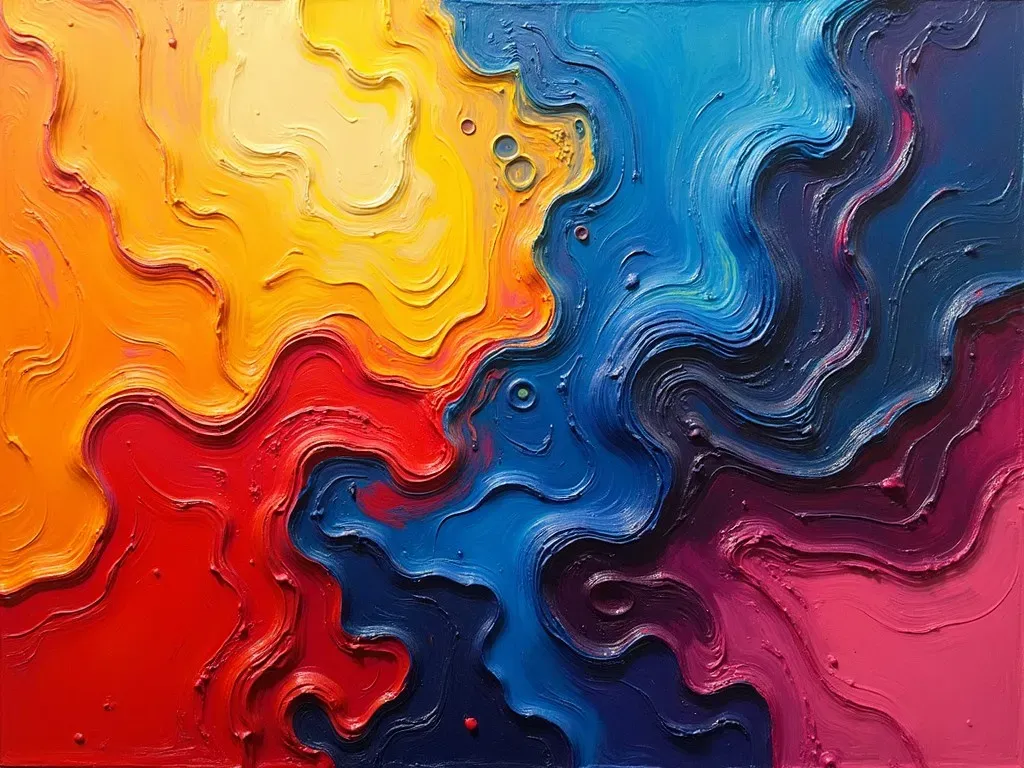Abstract art acrylic painting techniques allow artists to explore innovative ways to express their emotions and ideas on canvas. This style prioritizes expression over representation, enabling you to create paintings that resonate with your feelings and experiences without the constraints of traditional forms. By understanding and employing various Techniques, both beginners and experienced artists can push the boundaries of their creativity using acrylic paints.
Techniques to Explore
1. Acrylic Wash & Ink
One of the simplest abstract acrylic painting techniques is the acrylic wash paired with ink. This technique involves diluting acrylic paint with water to create a thin, translucent layer. Applying this wash to the canvas can produce soft, ethereal backgrounds. Alternatively, you can use acrylic ink, which can be applied with a dapper for a more controlled distribution of paint.
2. Pouring Technique
The pouring technique has gained popularity for its mesmerizing results. To implement this method, mix acrylic paint with a pouring medium to achieve a fluid consistency. Then, pour the mixture onto the canvas, allowing the colors to flow and blend into one another organically, creating stunning marbled effects.
3. Palette Knife Techniques
Using a palette knife to apply paint can add a rich texture to your artworks. This technique is excellent for creating bold strokes and dynamic patterns, as the knife allows for more precise control of paint application compared to brushes. You can also scrape the surface to reveal underlying layers, adding depth to your piece.
Facts in Table Format:
| Technique | Description |
|---|---|
| Acrylic Wash & Ink | Thin, translucent layers using diluted paint or ink |
| Pouring Technique | Fluid colors that blend naturally on the canvas |
| Palette Knife Techniques | Bold textures and patterns created with a palette knife |
4. Stamping & Printing
Incorporating everyday objects and tools as stamps can enhance the visual appeal of your acrylic painting. Utilize sponges, bubble wrap, or even leaves to create unique prints on your canvas. This technique adds a layer of complexity and invites a playful and experimental atmosphere in your creations.
5. Splattering
This technique is about freedom and spontaneity. Take a brush or other tools to splatter paint across the canvas, allowing for random dot patterns. It can create a playful feel and introduce vibrant color specks into your abstract art. Experiment with different paint consistencies to achieve varied effects.
6. Dry Brushing
Using a dry brush with minimal paint can create a delicate, textured look. This technique is perfect for layering transparent colors to build a sense of depth. The interplay of colors becomes crucial as you gently drag a brush across the surface, revealing both the paint and canvas beneath.
7. Layering
Layering is integral to achieving depth and complexity in abstract acrylic paintings. Build your artwork gradually by applying multiple layers of paint, allowing each layer to dry before adding the next. This technique enables you to create intriguing effects by showcasing the interaction of colors and textures.
More Techniques in a List Format:
- Sgraffito: Scratching into wet paint to create texture or lines
- Masking Tape: Using tape to create sharp lines and shapes
- Glazing: Applying a thin transparent layer of color over dried paint to modify the tone
Tools and Materials
Using the right tools enhances your painting experience and outcomes. Here’s a list of essential tools for abstract acrylic painting:
Essential Tools
- Acrylic Paints: A range of colors including soft and vibrant hues
- Acrylic Mediums: Pouring medium, gel medium, and texture gel
- Paintbrushes: Various sizes and shapes for different effects
- Palette Knives: For spreading and adding texture
- Sponges and Rags: For blotting, dabbing, and creating textures
Suggested Surface Options
- Stretched Canvas
- Wood Panels
- Heavyweight Paper
Statistics on Abstract Art Appreciation:
- 30% of new art collectors prefer abstract art styles.
- 45% of artists state that acrylics are their preferred medium.
Color Theory for Abstract Painting
Understanding color theory enhances your ability to convey emotions through your artwork. The combination and contrast of colors can create distinct atmospheres in your painting.
- Warm Colors (Red, Yellow, Orange) evoke feelings of warmth, energy, and passion.
- Cool Colors (Blue, Green, Purple) can express calmness, peace, and tranquility.
- Neutral Colors (Black, White, Gray) can balance compositions and offer subtle shifts in tone.
Frequently Asked Questions (FAQs)
Q1: What type of acrylic paint is best for abstract painting?
A1: Look for high-quality artist-grade acrylics, which offer vibrant pigments and excellent coverage. You can also experiment with fluid acrylics for unique effects.
Q2: How can I create depth in my abstract art?
A2: Utilize layering techniques, contrasting colors, and varying brush strokes to build depth in your artwork.
Q3: Are there any preparation steps before starting an acrylic abstract painting?
A3: It’s beneficial to have a planned concept, gather your materials, and experiment with color combinations before starting. Priming your canvas can also help paint adhere better.
Q4: Can I use house paint for abstract art?
A4: While it’s possible, house paint may not provide the same quality and vibrancy as artist-grade acrylics. For best results, stick with art-specific products.
Q5: Where can I find inspiration for abstract painting?
A5: Explore art galleries, online platforms, like the Artists Network, art forums, and social media platforms dedicated to abstract art.
Image Placeholder – Example Art Piece
By exploring the diverse world of abstract acrylic painting techniques, artists at any skill level can create captivating works of art that showcase their unique visions. The beauty of abstract art lies in its ability to transcend realism and focus on emotional expression, enabling individuals to leave their mark on canvas creatively. So grab your Supplies, dive into your artistic journey, and let your imagination run wild!
